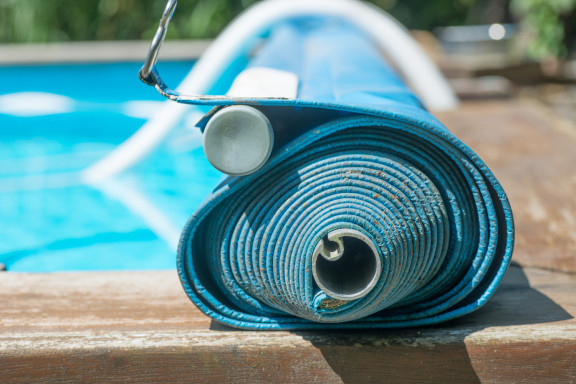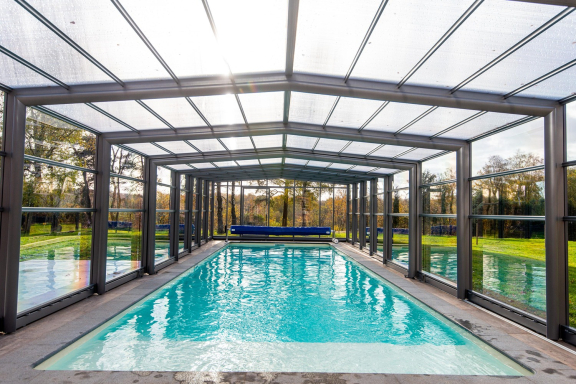Which cover should you choose for an above-ground pool?
The pool cover, a must-have for any above-ground pool, offers a host of benefits for anyone who has a pool space in their garden. An extensive range of models exist on the market today, tailored to various seasons and/or regulations in effect. Compare models and make the right choice when purchasing your above-ground pool cover.
Benefits of a cover for your above-ground pool
The tarp cover for an above-ground pool, an alternative to a rigid cover or a pool enclosure is now a piece of must-have pool equipment as it's easy to install and it's highly-affordable. It boasts a host of benefits when used for an above-ground pool, including:
- It ensures water quality is preserved as it protects from external aggression and impurities (dead leaves, pollution, insects, spread of algae, etc.)
- It ensures pool water temperature remains stable as it plays a barrier role and prevents heat loss caused by water evaporation;
- It protects from bad weather (water freezing in winter, rainwater, etc.).
When you have a cover over your above-ground pool, pool cleaning is quicker (less impurities in the water and less dirt around the inside pool walls). And, when you opt for a wintering cover for your pool (see below), it's easier to get your pool up and running after winter.
Protective, wintering cover
The protective pool tarp, wintering tarp or wintering cover is the most commonly-used cover for above-ground pools and, as its name suggests, is intended to protect your pool from winter weather conditions. In practical terms, the wintering cover for above-ground pools avoids you having to empty and drain your pool when the first signs of winter appear. The wintering cover for above-ground pools is sturdy, resistant, opaque, equipped with a rainwater evacuation system, and it fulfils several missions:
- it reduces the risk of water freezing when outdoor temperatures drop;
- it prevents photosynthesis responsible for the development of algae in pool water;
- it acts as a safety system, provided it's NF-P 90.308-approved (see below).
If you purchase a wintering cover for your above-ground pool from a first-class manufacturer, some models are designed to last over 10 years. This type of cover should be installed from the end of your pool season (in autumn or in winter, based on regions), right through to the start of spring. Generally-speaking, a wintering cover for an above-ground pool is installed using stakes fixed around the pool coping/rim and then attaching your protective cover to these with elastic bands.

Summer solar cover
The summer solar pool tarp or pool cover, generally in the form of a bubble cover, is a type of cover used to protect a pool during the summer season. The summer solar cover for above-ground pools, much easier to install than a wintering cover, is usually set up when the pool isn't being used (at night for example). The summer pool cover plays a twofold role: to protect water quality and temperature (and even increase the temperature, thanks to the sun's rays on the cover). The summer cover, placed directly on the pool water surface, can be of a roller type, placed at the end of the pool, or a simple pool cover that just needs to be removed when you wish to use your pool. It's important to note, however, that most summer covers for above-ground pools aren't intended to ensure personal safety and are in no way meant as a solution for making your pool safe.
4-season cover
As you can easily guess from its name, the 4-season cover is a type of cover designed to protect your pool throughout the year. Its main advantage is that it means you only need to invest in pool protection equipment once (versus twice if your purchase a wintering cover and a summer cover) Like other types of cover for above-ground pools, the 4-season cover can be motorized, to make it easier to use.
Safety cover
In France, regulations require pool owners to protect their equipment with a safety system intended to prevent risk of drowning, in particular where young children are concerned. In the event that it complies with the NF-P 90.308 standard, the pool cover can be considered as a safety item (just like a safety barrier, audible alarm or pool enclosure that totally covers the pool). Pay attention when you choose a protective cover for your above-ground pool and make sure you opt for a cover that complies with safety standards. Practically-speaking, a pool safety cover should be able to resist a shock of 100 kg without ripping. The general idea is that a child who falls into a tarp-covered pool should be able to reach the edge of the pool without falling into the water or being rescued by an adult.


